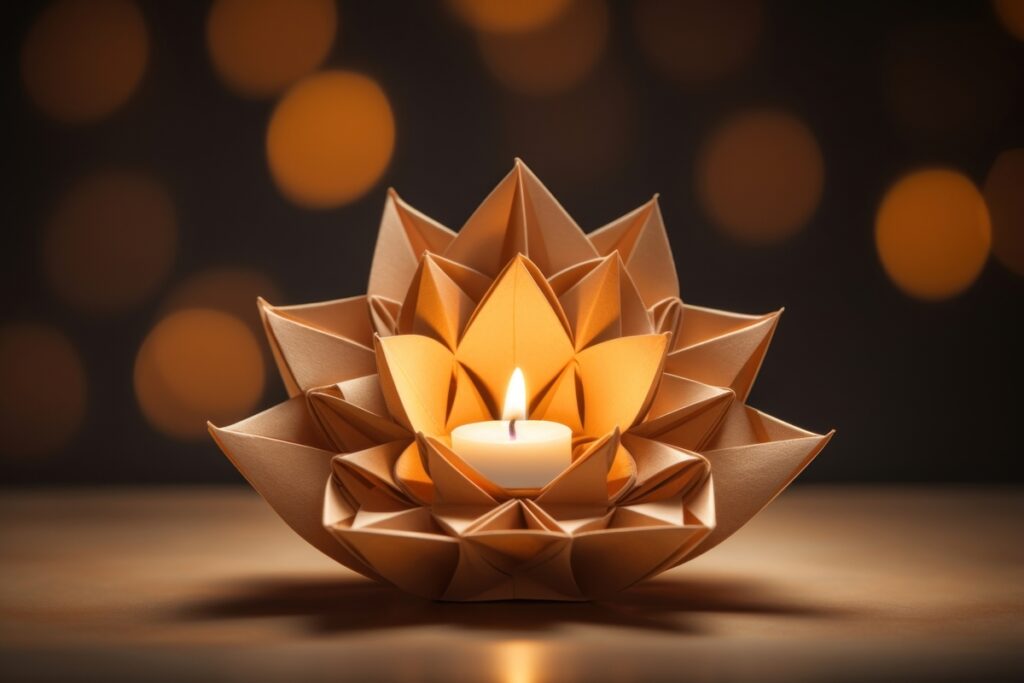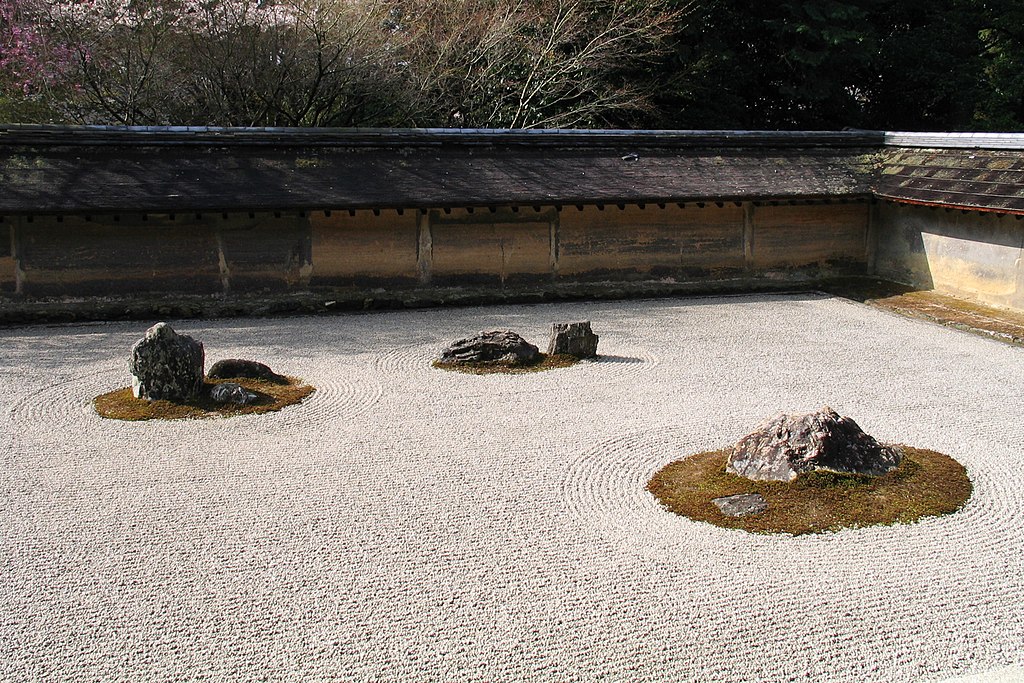Key Takeaways
- Origami can serve as a form of moving meditation, mirroring Zen practices in its focus on mindfulness and presence.
- The simplicity and minimalism in origami design reflect Zen principles of emptiness and essence.
- Origami’s ephemeral nature embodies the Buddhist concepts of impermanence and non-attachment.
- The practice of origami can foster a sense of harmony and interconnectedness with nature, aligning with Zen perspectives on unity and interdependence.
As a foreign graduate student living in Japan, I was captivated by origami through a chance encounter. Stumbling into a small gallery in Nara, I saw an origami crane sculpted with such vitality that it seemed poised to take flight. This brief artistic epiphany sent me on a lifelong journey to uncover origami’s depths. What began as amusement grew into a practice of meditation, mindfulness, and spiritual insight reflecting core Zen concepts.
My first Japanese origami lessons came from a generous grandmaster, Abe Sensei, who saw my sincere enthusiasm. With an abiding reverence for tradition, he revealed how nature’s geometry underlies each crease and fold. From him, I learned techniques unchanged since the Heian Era when origami adorned sacred texts in Shinto ceremonies. Yet origami’s possibilities still felt boundless.
As I folded and refolded paper late into the night, origami became a moving meditation. The world receded as I entered intense focus and flow states through the repetitive precision folding required. With paper as my medium, I could touch the essence of cranes, sea turtles, orchids emerging crease by crease. Origami’s meticulous hand-eye coordination and repetition of folds mirrors core Zen practices like mindful breathing, chanting mantras, or mending robes, inducing tranquil concentration.
Attracted by its meditative essence, I also trained in the art of kyudo, Japanese archery. In the dojo’s stillness, firing arrows into unseen targets, I learned to empty the mind and body until they became one with the target. This helped deepen my origami practice, integrating kyudo’s teachings on absolute presence and non-attachment. Each crease became a mindful step on the path to liberation.
Origami’s ceremonial folding mirrors kyudo’s meditative ritual, distilling artistry into mindful movements revealing inner truth. Beyond any particular religion, origami unlocks an essence that many spiritual seekers strive to unveil – an ineffable suchness glimpsed in stillness as paper transforms. In Japan, origami most tangibly integrates with Zen’s poetic reverence for nature, art, and the mysteries of being.
Table of Contents
Origami as a Contemplative Practice
The meticulous hand-eye coordination involved makes origami akin to a moving meditation practice requiring complete presence. The origami process demands unwavering concentration and attention, mirroring core Zen principles of mindfulness and focus. Origami requires being fully in the moment, merging action, awareness, and object – much like the total absorption cultivated in zazen.
The complex sequence of folds and intricate paper manipulation oblige the folder’s absolute focus in the present moment. Any distraction can lead to tearing the delicate paper or having to undo misfolded creases. The origami artist must fully inhabit each finger position and paper tension, paying close heed to every subtle cue as the form manifests. In this, origami exemplifies the Zen notion of being the brush stroke or tea ritual rather than thinking about it.
This total immersion creates a meditative stillness and tranquil concentration similar to zazen, or seated Zen meditation. Origami’s motions yield a quiet mind unperturbed by the chatter of thoughts. In such one-pointed absorption, the folder enters a state of serene flow. The pinnacle of origami mastery approaches the satori experience of supreme Zen awakening.
Origami also requires repetitive hand movements reminiscent of Buddhist mala beads or chanting a mantra. The continual intricacy of valley and mountain folds concentrates purposeful energy through centering repetition. Just as Buddhist mantra repetition engenders insight, origami’s physical sequences build technical proficiency and mental acuity. Through devoted origami rituals, tranquility emerges.
In learning from Japanese masters, I discovered the senbazuru -one thousand cranes- ritual, traditionally undertaken to show devotion or pray for recovery from illness. But its spiritual potency transcends any particular intention. The journey of folding one thousand cranes calms the tempestuous monkey mind, opening the heart-mind to presence. Mindfully completing each crease purifies karma and quietens the ego-self, revealing one’s true nature.
Through origami’s demands for precision and repetition, meditative stillness arises. After years of practice, advanced origami artists describe how prolonged concentration results in an elevated peace. Such devoted focus purifies the mind, unfolding inner tranquility. Origami seamlessly fuses artistry, meditation, and mindfulness much as Zen pursuits like the tea ceremony cultivate awareness through attention.

Simplicity and Emptiness in Origami Design
Origami’s minimalist aesthetic resonates with Zen principles of simplicity, subtraction, and suggestion. Folding sculptures from a single sheet of paper without any cuts or glue requires immense restraint and care. Nothing superfluous can remain; every technique employed must directly serve the essence of the form. This reflects the Zen ideal of expressing the infinite within the finite through creative limitation and simplicity.
This limitation breeds ingenious simplicity. Complex shapes arise from elemental techniques repeated in novel combinations. Decorative accessories are eschewed, compelling origami to distill subjects down to their vital energy. Each fold must build potency and presence through precision. Origami therefore epitomizes the profound richness that Zen finds in austere restraint.
References to animals, figures, or natural elements are subtly evoked through sparse elegant folding. Origami crane designs dispense with decorative plumage to manifest the crane’s quintessential form and spirit through poise. By paring down subjects to sparse symbols, origami focuses the viewer’s imagination much as Zen painting uses minimalist suggestions to stir deeper awareness.
This emphasis on elementary folding reveals origami’s parallel to Zen arts like calligraphy and meditation. With the lightest of brush strokes or the simplest of seated positions, Zen arts unveil truth by stripping away the unnecessary. Origami similarly uncovers essence through simplicity, leading to contemplative awe at life’s profound suchness.
Origami’s transformative process also refashions raw paper into a soaring egret or colorful blossom, reflecting the Buddhist view of the illusory nature of reality. That which begins as empty paper through mindful folding assumes an idealized yet ephemeral existence. Origami renders tangible the Zen idea of “form is form, emptiness is emptiness” with each cycle of paper folding and unfolding. Through creative limitation, origami manifests the boundless.
Impermanence and Non-Attachment
The ephemeral paper sculptures folded through elaborate origami sequences poignantly convey the transitory and fleeting nature of all phenomena. Existence is revealed as contingent, contingent, and dependent on innumerable conditions that pass and change. This constant flux is a core Zen teaching on impermanence.
An origami artist may spend years perfecting an original crane’s folding technique. Yet, as all compounded things must, the delicate paper construction will unavoidably and intentionally deconstruct back into blank potentiality. The creative vision and labor invested dissipate as the origami returns to flat blankness. This mirrors the Zen view of releasing attachment to any fixed ideas or outcomes.
Such deliberate impermanence forces acknowledgment of the hollowness of attachment. For origami creators, non-attachment and non-grasping are essential attitudes; any clinging leads only to suffering given origami’s purposeful ephemerality. The paper medium prevents permanence. Origami’s unfolding and dissolution train mastery over desire and realization of voidness, resembling Zen techniques to cultivate non-attachment.
Rather than desiring a lasting legacy through works frozen in time, origami requires embracing ceaseless flux. Each temporary manifest piece celebrates the singular gathering of elements giving rise to a singular form just as striking and fleeting as a dewdrop, rainbow, or human life. Through creative surrender to impermanence, origami unfolds wisdom.

Origami and the Search for Enlightenment
Some have made direct parallels between origami practice and Buddhist spiritual paths to awakening. The “Pure Land Folding” movement adapts Pure Land Buddhism’s theory of rebirth into the Pure Land paradise through folding paper cranes.
Pure Land Buddhists recite the name of Amida Buddha to be reborn in the utopian Pure Land after death. Pure Land folders similarly repeat the Buddha’s name with utmost devotion while folding paper cranes as a moving mantra. Each fold purifies karma, unfolding the enlightened mind. Completing one thousand cranes guarantees rebirth into boundless compassion. The origami ritual enacts the seeker’s journey to enlightenment.
Whether aiming for rebirth or not, origami holds meditative potential to reveal one’s true nature. As the paper transforms, consciousness arises folding back upon itself, illuminating its functioning. Reflecting upon origami’s unfolding instills insight into dependent origination and the emptiness of all mental constructs. Origami can reveal the non-dual Buddha nature inherent in all things.
Studying revered origami masters like Akira Yoshizawa provides further inspiration. Yoshizawa integrated deep Zen awareness into his creative process through meticulous observation of nature. Each gracefully vital sculpture seems to capture the suchness of the creature itself. His approach turns origami into a transcendent practice touching infinite lifeforce and absolute reality. Origami masters approach mastery on par with Zen sages.
Though not a formal Buddhist technique, origami can awaken dormant dimensions of being. As an artistic ritual of presence and stillness, origami folds consciousness into enlightened forms. Creative flow fills paper and mind with luminescence. With devotion, origami’s potential unfolds without limit.
Harmony and Interconnectedness
Creating origami versions of plants, animals, landscapes and other natural subjects honors the Buddhist principle of interdependence and the intrinsic worth of all life. By recreating nature in a microcosm, origami pays homage to its multiplicity and unity. This reflects Zen’s recognition of the universal Buddha nature permeating all existence.
Mindfully folding an orchid or elephant grass honors that being’s singular essence and place in the ecology of existence. Origami reverentially recognizes that diversity relies on an interconnected whole. All phenomena deeply interrelate as flowers rely on clouds and bees on pollen. Origami instills a visceral realization of indivisible interbeing.
The study of nature’s forms facing the elements reveals much about structural strength as well as fragility and flexibility. Origami applied respectfully can replicate how a tulip’s creased petals and fibrous stems hold the flower up into the sun, and how a bird’s wings provide lift and maneuverability through the breeze. Origami thus celebrates the brilliance of nature’s boundless creativity through harmonious resonance.
Origami also epitomizes the Buddhist truth of non-duality. As hand, paper, and form merge during creation, boundaries dissolve between conception and materialization. The crane shape and paper medium become one ongoing dance. Such seamless unity reflects the boundlessness of Zen’s “not two.” Origami dissolves subject-object division through total absorption in the creative act.
With focused practice, origami’s peaceful co-creation of form unveils humankind’s interbeing with all life. Each singular paper fold honors nature’s web and our creative role within its tapestry. Origami can awaken transcendent ecological awareness.

Conclusion
My origami journey has deepened through all its myriad revelations and ineffable mysteries, leading to an abiding sense of inner tranquility and cosmic belonging. While no substitute for formal Zen training, the creative ritual of paper folding integrates and actualizes many contemplative teachings in direct tactile ways.
The process mirrors such concepts as presence, impermanence, emptiness, essence, interdependence, and non-duality — folding them into three-dimensional life. Origami instills experiential comprehension of these subtle truths, grounding them physically through skillful and devoted craftsmanship.
As both meditative discipline and creative art, origami provides a ritual enactment of an awakened mind. Beyond decorative diversion, mindful paper folding unveils eternal verities, flowing like creases into stillness. Each fold becomes an opportunity to peel back the veil of the real, revealing life’s boundless luminosity.
Further Reading
If you found this connection between origami and Zen captivating, I recommend Maria Sinayskaya’s wonderful book “Zen Origami” featuring 20 beautiful modular origami projects explicitly designed to induce mindful calm. With 400 high quality sheets of origami paper included, it makes a perfect gift for creative friends or personal enrichment.
Readers interested in further exploring connections between Zen, mindfulness, and storytelling may enjoy “The Zen Monkey and the Lotus Flower” by Tenpa Yeshe. This book features 52 Buddhist-inspired parables and fables full of wisdom and peaceful life lessons. Like origami stories can unfold deeper truths through mindful hands, these short tales use symbolism and metaphor to reveal insight about living harmoniously, overcoming struggles, and finding inner tranquility.



